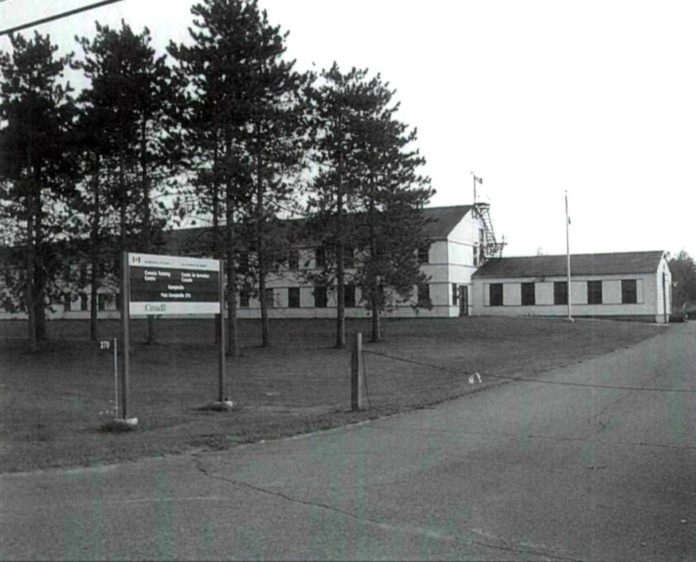At the height of the Cold War, the Canadian Government took steps to ensure the Continuity of Government in the event of a nuclear attack on Ottawa. Between 1959 and 1962 a self-sufficient, shock-resistant, reinforced, radiation-proof underground complex with an elaborate protected communications network was built in Carp, known forever after as the Diefenbunker, after the Prime Minister of the day, John Diefenbaker. It remains today as a tourist destination and a reminder of days of fear and threats.
What is not so well known is the fact that the Diefenbunker was not the only secret location in which government officials could shelter in case of a nuclear attack: Kemptville, too, had its own smaller version of the Diefenbunker. It was realised in 1960 that the Carp location could not cater to all of the officials that would be needed to ensure Continuity of Government, so a series of other buildings was planned. In the event, only two in Kemptville and Carleton Place were actually built.
These two installations were known as Federal Readiness Units and were under the direction of the Emergency Measures Organization (EMO), a co-ordinating body of the Government. A two-storey building was built on Highway 16 (now County Road 44) across the road from the entrance to the Ferguson Forest Station. Before the building was ready for occupation, a special underground bunker was added to the structure to protect those using the site in the event of a nuclear attack. The locations of these as Federal Readiness Units were chosen to be close to Ottawa, for ease of access, and had to be south and west of the capital to escape radioactive clouds that would be spread by the prevailing winds which blow from the west.
The Kemptville location was also chosen to be the back-up centre should the Diefenbunker itself be compromised, which meant that Kemptville would then become the government and communications centre for the Canadian Government. Cabinet Ministers and senior government officials would be divided between the Diefenbunker, the Kemptville site and the Carleton Place location, to ensure that government could continue even if two of the three sites were destroyed in an attack.
Originally designed to house forty people for between fifteen and twenty days, complete with food, supplies, water, electricity, etc., it was decided in 1961 that the Kemptville Unit be enlarged to accommodate 100 people, with reinforced walls and ceilings to make it even more secure from bombs. At the time of the Cuban Missile Crisis in 1962, only the three locations were completed, and plans for other sites never resulted in actual buildings, aside from a Relocation Centre in Smiths Falls.
The Kemptville Unit had an operations and information display centre, work areas, a kitchen, dining room, dormitories, and a sickbay. According to one source on this secret facility: “Storage rooms contained food, equipment and supplies to sustain eighty people for fourteen or fifteen days. The message and communications centre and essential records vault were centrally located. Access could be gained only by passing through a decontamination area with a disrobing area, showers, a supply of clean clothing, and a dressing area. It was located at the bottom of the stairway that led down from the front entrance on the ground floor. The facility drew electricity from the local commercial power supply, but standby power was available from an emergency generator. Life support systems included a heating system with fifteen days supply of fuel, air conditioning, and a ventilation system designed to filter outside air for radioactive particles. Relocation sites were constructed on solid bedrock for maximum stability. Occupants drew water from on-site wells.
Two tunnels led from the exterior to the decontamination area. Personnel could enter or escape the bunker through heavy steel interior doors, while it remained sealed off from the readiness unit. Sand was packed into the tunnels to prevent collapse and provide an air-tight seal against radiation, but could be removed to facilitate access or egress, and the tunnels refilled. Both sites still contain their original diesel generators. The one in Kemptville was still working during the ice storm in 1998.”
After the end of the Cold War, the Kemptville site was handed over to the RCMP as a training facility, and it was only in the last ten years or so that it was finally closed and demolished. But for a time, Kemptville was, whether residents knew it or not, at the centre of Canada’s response to the Cold War and an essential part of the Canadian Government’s plans for surviving and recovering from a nuclear war.








What an awesome article. I love “did you know” pieces. I am going to suggest my daughter (grade 7 @ St. Mike’s) use the story and reference to your article as a school speech to share this with the younger generation who may not read the paper regularly. Thanks
was used during 98 ice storm as well. I had a few meals there when I was helping out.
At the outbreak of the Ice Storm after declaring a disaster I knew we needed a HQ to coordinate all activities and knew all govt bldgs. would have a generator so sent the police to bring the Commissionaire to our meeting, turned out to be RCMP, who agreed to use the bldg., it was quite rundown but Tim Bond Fire Chief after considerable work got the generator going. We used this site for 28 days til the last light went on. Even put up 200 soldiers here and all key members of the task force.
I live reading local stories. Thank you for sharing.
never in a million years I thought this was going on,Sad but true.
Ha! How interesting… I was a student at KCAT 1978-80, at the beginning of my 2nd year in september 1979 our residence accomodations were changed from main campus to that building!! A hell of a walk it was every day from there to the main campus, I did’nt have a car…after a while I went back to the main res. across from the MNR building. We knew nothing of the health hazards, of course…!! I will investigate further.
Gilles Cordier